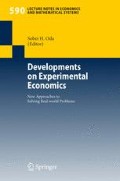Abstract
Regulating a natural monopoly market has always remained a source of concern. The problem arises because of the decreasing average cost structure in the market. Ideally, only one firm serving the whole market demand is the efficient solution to avoid any cost duplication. However, when there is a single unregulated firm serving a market it brings up the standard monopoly price-gouging problem. Many utility services share the characteristics of a natural monopoly. As a result, almost all countries in their deregulation phases are concerned with the efficient running of such markets. Restraining monopoly behavior effectively in a natural monopoly market remains a much-debated issue. The idea of creating a “contestable”1 environment has influenced USA, UK and many other countries during their deregulation phase. In a perfectly contestable market2 the threat of hit-and-run entry by new entrants in the monopoly market can provide the right disciplining stick for the monopolist incumbent to charge a price equal to the average cost of production (the Ramsey optimal price). This outcome is described as a contestable (market) outcome3.
I thank James C. Cox, Martin Dufwenberg, Stanley Reynolds the participants at the ESA 2004, EES 2004 conferences and the editorial board for useful and critical sugestions. I also extend my gratitude to Professor Hidetoshi Yamaji and the organizers of the EES 2004 conference for giving me an opportunity to present my work. A special thanks to Todd Sorenson for his insight in programming the software. Financial Support from the Experiment Science Laboratory at the University of Arizona is gratefully acknowledged.
William Baumol in his 1981 address as outgoing president of the American Economic Association put forward the idea of a contestable market.
A perfectly contestable market is devoid of any sunk entry costs. So an entrant can enter a market whenever there are profit opportunities without worrying about sunk costs.
Baumol Panzar and Willig [1]
Access this chapter
Tax calculation will be finalised at checkout
Purchases are for personal use only
Preview
Unable to display preview. Download preview PDF.
References
Baumol W, Panzar J. and Willig R (1982) Contestable Markets and the Theory of Industry Structure Harcourt Brace Jovanovich, New York.
Bernheim D and Whinston M. (2000) Multimarket Contact and Collusive Behavior Readings for Contemporary Economics. Malden, Mass. And Oxford Blackwell
Brock W. (1983) Contestable Markets and the Theory of Industry Structure: A Review Article Journal of Political Economy 91: 1055–56
Brown-Kruse Jamie L. (1991) Contestability in the Presence of an Alternate Market: AN Experimental Examination The RAND Journal of Economics 22: 136–147
Call Gregory D., Keeler Theodore E. (1985) Airline Deregulation, Fares, and Market Behavior: Some Empirical Evidence In: Daughety Andrew F (Eds) Analytical Studies in Transport Economics Cambridge: Cambridge University Press: 221–47
Coursey D, Issac R, and Smith V. (1984) Natural Monopoly and Contested Markets: Some Experimental Results Journal of Law and Economics 27: 91–113
Dasgupta Utteeyo (2005) Contesting Contestability Working Paper
Dasgupta Utteeyo (2005) Minding Your Own Business Working Paper
Dixit A (1980) The Role of Investment in Entry Deterrence Economic Journal 90: 95–106
Evendyn Rhys D, Williams Alan W. (2000) Contestability: The Debate and Industry Policy Economic Analysis and Policy v30: 75–91
Harrison G. (1987) Experimental Evaluation of the Contestable Markets Hypothesis. In: Bailey Elizabeth (Eds) Public Regulation The MIT Press
Harrison G, McKee M. (1985) Monopoly Behavior, Decentralized Regulation, and Contestable Markets: An Experimental Evaluation Rand Journal of Economics 16: 51–69
Harrison G, McKee M. and Rutstrom E.E. (1987) Experimental evaluations of institutions of monopoly restraints: In Green L and Kagel J. (Eds) Advances in Behavioral Economics, vol. 2 Norwood, N.J: Ablex Press, 54–94
Rapoport Amnon, Seale Darryl A. and Winter Eyal (2000) An experimental study of coordination and learning in iterated two-market entry games Economic Theory 16: 661–687
Schwartz M. and Reynolds R (1983) Contestable Markets: An Uprising in the Theory of Industry Structure: Comment American Economic Review 73: 488–90
Schwartz M. (1986) The Nature and Scope of Contestability Theory Oxford Economic Papers, New Series, Vol. 38, Supplement: Strategic Behavior and Industrial Competition: 37–57
Shepherd W (1984) “Contestability” vs. “Competition”, American Economic Review 74: 572–87
Tye W (1985) On the Applicability of the theory of Contestable Markets to Rail/Water Carrier Mergers Logistics and Transportation Review 21: 57–76
Urs Fischbacher: z-Tree-Zurich Toolbox for Readymade Economic Experiments-Experimenter’s Manual, Working Paper Nr. 21, Institute for Empirical Research in Economics, University of Zurich, 1999
Weitzman M. (1983) Contestable Markets: An uprising in the Theory of Industry Structure: Comment. American Economic Review 73: 486–487
Zwick Rami, Rappoport Amnon (2002) Tacit Coordination in a Decentralized Market Entry Game with Fixed Capacity Experimental Economics 5: 253–272
Author information
Authors and Affiliations
Editor information
Editors and Affiliations
Rights and permissions
Copyright information
© 2007 Springer-Verlag Berlin Heidelberg
About this chapter
Cite this chapter
Dasgupta, U. (2007). When Firms Contest in Markets: An Experiment. In: Oda, S.H. (eds) Developments on Experimental Economics. Lecture Notes in Economics and Mathematical Systems, vol 590. Springer, Berlin, Heidelberg. https://doi.org/10.1007/978-3-540-68660-6_25
Download citation
DOI: https://doi.org/10.1007/978-3-540-68660-6_25
Publisher Name: Springer, Berlin, Heidelberg
Print ISBN: 978-3-540-68659-0
Online ISBN: 978-3-540-68660-6
eBook Packages: Business and EconomicsEconomics and Finance (R0)

